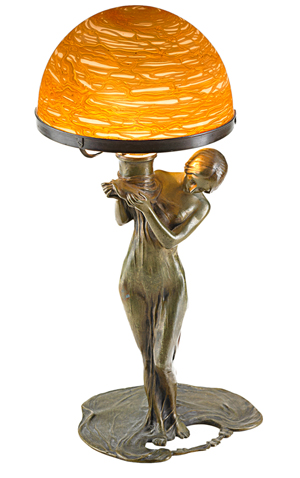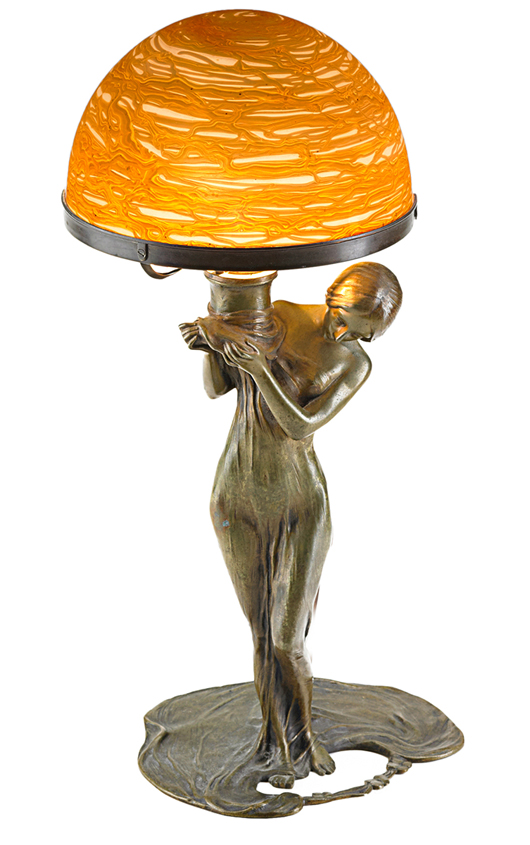
BEACHWOOD, Ohio – Electric lights were first marketed to the public about 1880. It is said that Louis Comfort Tiffany’s famous lily lamp with glass shades for light bulbs was the first lamp with a shade that projected light down, not up, like a candle flame. Other lamps of the early 1900s were adapted to accept bulbs by removing the older light source, like a candle, then wiring the lamp for electricity and adding a bulb and shade. Others were made in entirely new shapes.
During the Art Nouveau period, sensuous women with curves were part of the designs used for glass, ceramics, bronze figurines and even furniture. So it is not surprising that a variety of lamps designed to feature women also were made. The Loetz glass factory (1840-1940), in what is now the Czech Republic, made art glass. At around the turn of the 20th century, workers there designed a figural lamp with a bronze base shaped like a woman holding an iridescent gold glass shade above her head. The glass resembled Tiffany’s, but it was actually made at the Loetz factory. It was signed by Peter Tereszczuk (1875-1963), a well-known Ukrainian sculptor who made bronze figurines and other decorative bronzes.
Bell collectors prize his bronze electric call buttons that look like a small child on a rocky base. The lamp sold for $3,750 at a Rago Arts and Auction sale in 2013.
Q: My old gate-leg table has a label that says it was made by the John D. Raab Chair Co. The finish on the table is a bit worn and marred. I have been considering refinishing or painting it, although I think this would decrease its value. What do you think?
A: The John D. Raab Chair Co. was in business in Grand Rapids, Mich., from 1906 to 1924, when it was taken over by the Furniture Shops of Grand Rapids. If you like the table and plan to use it, go ahead and refinish or paint it. “Brown furniture” pieces like your table are not selling for much money today, and many people are buying them at bargain prices, then refinishing or painting them to either use or resell.
Q: I would like information on a metal toy roller coaster that was given to my son in the early 1970s. It was made by J. Chein & Co., of Burlington, N.J. It’s about 20 inches long, and has two cars propelled by an elastic band wound by a key. A ticket booth, hot-dog stand, cotton candy stand and children are pictured around the sides. Is it valuable or collectible?
A: Julius Chein emigrated from Russia in 1893 and opened his toy company in New York City in 1903. The company moved to Burlington in 1949. The roller coaster was one of several amusement park toys made by Chein. It was designed by model-maker Eugene Bosch in 1949 and was made until the late 1960s. The lithographed pictures around the base were changed several times, and different colors were used. A 1950s version pictures a sideshow. Chein stopped making toys in the 1970s. The company was sold in 1987, became Atlantic Cheinco and filed for bankruptcy in 1992. The sideshow version from the 1950s sells for $150 to $400. Your version with a hot-dog stand is less than $100.
Q: I would like to know something about the maker of a platter that has been in my family for years. It’s marked “Greenwood China, made for P, JB and Sons, Hotel Department,” and “Greenwood China, Trenton, N.J.” is impressed on the back. Can you tell me how old this is?
A: Greenwood Pottery was founded in 1868. It began marking pieces “Greenwood China” in 1886. During the early 1900s, Greenwood Pottery and Greenwood China were listed at separate addresses in Trenton, although they were under the same management. Dinnerware, hotel ware, restaurant ware and other items were made. Hotel china was marked with the letter “P” underneath “Greenwood China.” The pottery also made porcelain marked “Greenwood Art Pottery.” The art pottery ewers and vases can sell for more than $1,000 each. Greenwood Pottery was out of business by about 1933.
Q: We own an Art Nouveau vase signed “Val St. Lambert.” It’s 16 1/2 inches high. Can you tell us something about it, including what it’s worth?
A: Val St. Lambert Cristalleries (glassmaking factory) was founded near Liege, Belgium, in 1826. The only glassmaking company in Belgium, it still operates today (visit Val-Saint-Lambert.com). The company is best known for its Art Nouveau (c. 1895-1905) and Art Deco (c. 1925-1935) glassware. The size and style of your vase may mean that it could sell for more than $1,000. Have an expert in your area take a look at it.
Q: I found a $1,000 certificate from the Bank of the United States among my father’s things after he died. It’s dated Dec. 15, 1840, and is No. 8894. There are portraits of six men along the sides. The only one I recognize is Benjamin Franklin. Is this certificate valuable?
A: The Bank of the United States was chartered in 1791 in Philadelphia, which was the United States’ capital at that time. The men pictured on your note are David Rittenhouse (the first director of the U.S. Mint), William Penn, Thomas Paine, Robert Morris, Benjamin Franklin and Robert Fulton. An original bank note would sell for more than $100, but this particular bank note is a commonly found fake.
Tip: Be careful when handling birdhouses, birdcages and bird feeders, old or new. It is possible to catch pigeon fever (psittacosis) through a cut or even from breathing the dust.
Terry Kovel answers as many questions as possible through the column. By sending a letter with a question, you give full permission for use in the column or any other Kovel forum. Names, addresses or email addresses will not be published. We cannot guarantee the return of any photograph, but if a stamped envelope is included, we will try. The volume of mail makes personal answers or appraisals impossible. Write to Kovels, Auction Central News, King Features Syndicate, 300 W. 57th St., New York, NY 10019.
CURRENT PRICES
Current prices are recorded from antiques shows, flea markets, sales and auctions throughout the United States. Prices vary in different locations because of local economic conditions.
- Kewpie wedding topper, celluloid, wedding dress, holding bouquet, 1930s, $55.
- Pewter chalice, raised, molded base, concave stem, wedding band knot, tulip cup, flared rim, 9 x 4 1/2 inches, $95.
- Wedding Ring patchwork quilt, multicolor, scalloped edge, c. 1910, 76 x 95 inches, $120.
- Lladro bride, groom figurines, No. 4808, 7 1/2 inches, $130.
- Paper doll set, Wedding of the Paper Dolls, bride, groom, maid of honor, bridesmaid, Merrill, 1935, 10 inches, $150.
- Sterling silver wedding cup, woman wearing long dress, stamped, 5 inches, $210.
- Woven bamboo wedding basket, brass mounts, four tiers, handles, Chinese, 39 x 34 inches, $355.
- Oil wedding lamp, white opaline reservoirs, brass burners, Ripley, E.F. Jones, 1859, 13 3/4 x 9 1/2 inches, $575.
- Chief Rain-in-the-Face and wife wedding photograph, silver gelatin, 6 x 8 inches, $590.
- Stove plate, “The Wedding Dance 1746,” cast iron, 26 x 22 inches, $1,420.
Special offer. Free gift bag when you buy The Label Made Me Buy It, by Ralph and Terry Kovel. It’s a picture history of labels that once decorated products from cigar boxes to orange crates. The 320 full-color labels picture Native Americans, famous people, buildings and symbols. Learn how to identify and date labels, or just enjoy the rare pictured labels (hardcover, 224 pages). Out-of-print but available at KovelsOnlineStore.com. By mail, send $40 plus $5.95 shipping to Kovels, Box 22900, Beachwood, OH 44122; or call 800-303-1996.
© 2013 by Cowles Syndicate Inc.

ADDITIONAL IMAGE OF NOTE



